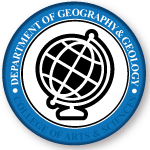Author ORCID Identifier
Document Type
Article
Publication Date
10-6-2019
Publication Title
Physical Geography
Abstract
In the mid-latitudes, snow plays a critical role in regional hydroclimate, with snow ablation variability in ephemeral regions representing an area of essential research. Due to a lack of historical snow-water-equivalent data in the eastern United States, recent research has substituted daily snow depth changes for ablation. These studies, however, do not explicitly examine if such a substitution yields a snowmelt hydrological signal, an important component of water resource management. As such, this study evaluates if ablation events, as defined as a daily snow depth decrease, subsequently result in increased river discharge within two similarly sized watersheds in the eastern United States: the Wabash and Susquehanna River basins. For both basins, >75% of snow ablation events resulted in a positive river discharge response (increase in discharge) at a 3-day lag. Furthermore, results show a significant and positive relationship between ablation event frequency and seasonal discharge response, such that an increase (decrease) in seasonal snow ablation event frequency yields an increase (decrease) in associated seasonal river discharge at a 3-day lag. These relationships indicate that inter-diurnal decreases in snow depth do carry hydrological implications, adding confidence that such a definition of ablation is appropriate for climatological applications.
Recommended Citation
Zachary J. Suriano, Gina R. Henderson & Daniel J. Leathers (2019): Discharge responses associated with rapid snow cover ablation events in the Susquehanna and Wabash River basins, Physical Geography, DOI: 10.1080/02723646.2019.1674558
Creative Commons License

This work is licensed under a Creative Commons Attribution-Noncommercial-No Derivative Works 4.0 License.
Funded by the University of Nebraska at Omaha Open Access Fund


Comments
© 2019 The Author(s). Published by Informa UK Limited, trading as Taylor & Francis Group.
This is an Open Access article distributed under the terms of the Creative Commons Attribution-NonCommercial-NoDerivatives License (http://creativecommons.org/licenses/by-nc-nd/4.0/), which permits non-commercial re-use, distribution, and reproduction in any medium, provided the original work is properly cited, and is not altered, transformed, or built upon in any way.